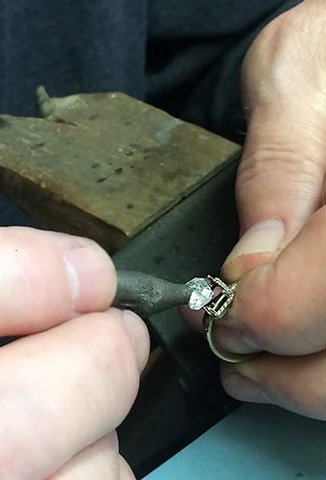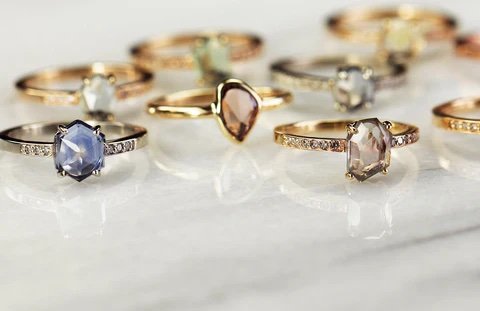A Guide to the Custom Jewelry Design Process
You’ve gone from one jeweler to another shopping for the perfect piece of jewelry, only to leave empty-handed every time. Sound familiar? If so, then you may want to consider creating a custom jewelry piece. Building a one-of-a-kind piece that is tailored specifically to the recipient’s unique style ensures that you receive the best value for your money. Clients are involved in each step of the process until a product is delivered that is as beautiful as they envisioned.
Here are some things that you can expect during the custom jewelry design process:
Custom Jewelry Design
The first stage of the custom jewelry design process involves an in-depth consultation between the client and a custom specialist. During this consultation, the client has an opportunity to bring his or her ideas and inspirations to the table.
Discuss what style of jewelry the recipient likes, what types of metals and stones are preferred, and any restrictions such as budgets or timeframes. It can be helpful to show photos of jewelry that closely resemble the look you’re trying to achieve.
Once the jewelry designer has a general idea of what the client wants, she will create a sketch that reflects the basic concept expressed by the client.
Metal and Stone Selection
One of the most important stages of the custom jewelry design process is the selection of the metal and stones. The type of metal and stones chosen will impact the durability, longevity, look, and feel of the jewelry.
There are several common types of metals used in handcrafted jewelry, including yellow gold, rose gold, and white gold in 10k, 14k, or 18k. The classification of the metal indicates its purity. For example, 18k gold contains 75 percent gold with traces of copper, nickel, and zinc alloy.
The type of metal chosen will also indicate its strength. Metals are categorized on the Mohs scale based on hardness. For example, 14k yellow gold is between a three and a four on the Mohs scale and contains alloys that make it a durable option for everyday wear.
Next, you will need to decide if you want gemstones in your custom jewelry. There are many types of stunning gemstones to choose from, such as rubies, emeralds, turquoise, topaz, amethyst, and sapphire. Gemstones can be found in countless colors, sizes, and shapes to fit the preference of the client.
Custom engagement rings and other pieces of fine jewelry often contain diamonds. Natural diamonds are truly one-of-a-kind and hand-selected for their strength, quality, and unique visual characteristics.
If you’re not sure what style of jewelry you want, ask your jeweler for recommendations. It might also be helpful to view pieces from current collections, such as Montana sapphire jewelry or rustic diamonds.
Of course, you don’t have to settle for one or the other. Many customers adore the look of gemstones and diamonds strategically arranged on a ring or bracelet. Consider a center diamond with a micro pave set of rubies or a diamond accented by two round sapphires. The possibilities are endless.
Jewelry Building Process
Once you have chosen your final design and have selected your metal and stone options, it’s time for the custom specialist to get to work.
Don’t worry, you’ll still be involved in the process. From start to finish, you’ll receive detailed photos of the diamond and gem selections, as well as pictures of the building process that can be shared with friends and family.
Clients can also expect exceptional customer service when they work with a trusted jeweler like Chinchar Maloney. No detail is overlooked, allowing clients to feel at ease that their project is in the hands of an experienced professional.
The complete custom jewelry design process takes an average of four to six weeks. Throughout this time, the client will receive email communications from the designer about the status of the jewelry.
At any time, the client can reach out to the custom specialist to ask questions or to see how the jewelry-building process is progressing.
Custom Jewelry Design FAQs
Clients who have never inquired about custom-made jewelry are often curious about this service. Here are some common questions and answers relating to the custom jewelry design process.
Is it expensive to build custom jewelry? No! The pricing for custom jewelry design is very reasonable.
Can you tell me what size ring I wear? Yes. Jewelers have access to certain tools and knowledge that can help customers determine their ideal size.
Is custom jewelry better quality than in-stock options? Despite common belief, the answer is no. Jewelers like Chinchar Maloney focus on creating high-quality pieces backed by impeccable craftsmanship for both their stock and custom pieces.
How do I choose a custom style for her? It can be challenging to choose a jewelry style for a loved one. Fortunately, the designer can ask questions to help target the perfect design.
Do engagement rings and wedding rings need to match? Not necessarily! However, many women enjoy wearing matching engagement and wedding rings. Consider having a custom wedding set created just for you.
How do I take care of custom jewelry? Your jeweler can provide you with detailed instructions on how to properly care for your custom jewelry.
Schedule a Consultation Today
From gold engagement rings with custom engravings to necklaces adorned with precious birthstones, the custom jewelry design process is open to so many possibilities. Jewelry is a personal accessory that often has special meaning to the wearer. While off-the-shelf jewelry is designed to appeal to a wide audience, custom jewelry designs are specifically tailored to the unique preferences of the recipient.
At Chinchar Maloney, our team of highly skilled jewelry designers will work directly with you at each step of the design process to ensure that you’re fully satisfied with the result. For more information about the custom jewelry design process or to schedule a consultation with our jewelry designers, contact Chinchar Maloney.




